Is the Milky Way normal?

Studying the large-scale structure of our galaxy isn't easy. We don't have a clear view of the Milky Way's shape and features like we do of other galaxies, largely because we live within it. But we do have some advantages. From within, we're able to carry out close-up surveys of the Milky Way's stellar population and its chemical compositions. That gives researchers the tools they need to compare our own galaxy to the many millions of others in the universe.
This week, an international team of researchers from the U.S., UK, and Chile released a paper that does just that. They dug through a catalog of ten thousand galaxies produced by the Sloan Digital Sky Survey, searching for galaxies with similar attributes to our own.
They discovered that the Milky Way has twins—many of them—but just as many that are only superficially similar, with fundamental differences buried in the data. What they discovered has implications for the future evolution of our own galaxy.
Digging through the data
To begin their search, the researchers narrowed their sample size by selecting only those galaxies that matched what we know about the Milky Way in three broad categories. First, they filtered for galaxies with a similar total mass to that of the Milky Way. Second, they ruled out galaxies with a vastly different 'bulge-to-total ratio' (the size of the galaxy compared to its bright central core). Finally, they only picked galaxies with a similar Hubble type, a classification system that groups galaxies based on their shape.
Some galaxies, like our own, are spiral-shaped, while others, usually older ones, are shaped more like fuzzy blobs, and are known as elliptical galaxies. There are other refinements possible within the Hubble classification system, including bar-shaped centers to some spirals, for example, but the idea was to use the classifications to find rough approximations of the Milky Way from which to begin the more detailed work.
At the end of this process, the team was left with 138 galaxies superficially similar to our own. From there, they could dig into the details to see just how close our galactic cousins really are to ourselves.
They plugged the data into a model that predicts star formation, taking into account how stellar winds blow excess gas away from star systems, which can be pulled in towards the center of galaxies. The model also accounted for the chemical composition and metallicity of materials within different regions of the galaxies.
So what did they find?
It turns out that there are indeed galaxies out there that look a lot like ours. 56 of the 138 galaxies in the sample ended up being a close match to home.

What characterizes these Milky Way-like galaxies is that they have a long timescale in which star formation occurs in their outer regions, steadily birthing new stars in a leisurely fashion. The inner region, on the other hand, experiences a dramatic period of intense star formation early in the galaxy's history, spurred on by a flow of gas being pulled inward towards the center from the outer region. Later, a much slower period of star formation in the core occurred, relying on recycled gas blown off of older stars in the outer region. These new stars, made of recycled material, have a higher level of metallicity, with heavier elements grafted into them that were lacking in the initial generation of stars. We see this pattern here at home in our own galaxy too.
But this isn't true for all 138 galaxies studied. A significant fraction of the galaxies which at first glance appeared similar to the Milky Way ended up looking very different on closer inspection. These fall into two categories.
The first category (consisting of 55 of the 138 galaxies) are galaxies that appear to have no differentiation at all between their inner and outer regions. These galaxies are experiencing star formation uniformly, in a long slow extended process without the wild burst in the core. In these galaxies, stars in both the inner and outer regions appear identical.
The second category, meanwhile, consists of what are known as 'centrally-quenched' galaxies (27 of 138), and these are perhaps the strangest of the bunch. These outliers seem to lack any significant period of recent star formation from recycled material in their cores, meaning that the radial inflow of gas from the outer regions that we see in the Milky Way isn't occurring in these galaxies.
One consistent feature of these centrally-quenched galaxies is that they appear, as a rule, to have completed most of their star formation in the past, hinting that perhaps they might be older than the Milky Way.
If that's true, perhaps we are looking at the Milky Way's own future. Our galaxy may someday also end up with a quenched center, and these galaxies therefore represent a preview of the next stage of galactic evolution.
"Perhaps these galaxies are the evolutionary successors of the Milky Way, which are further along in their lives," write the authors.
They also pose some other possible explanations, such as an overly active galactic nucleus that might subdue star formation in the inner regions of the galaxies.
There's still much to learn, but this study offers a lot of new possibilities to chew on when it comes to galactic evolution. Fundamentally, it shows that we are not entirely unique. There is an enormous variety of galaxy types in the universe, but at least some of them play by the same rules as the Milky Way, and many are at the same life stage. Studying these look-alikes can help us learn more about our own home, giving us the next best thing to holding our galaxy up to a mirror and showing us our reflection.
The paper, "Are Milky-Way-like galaxies like the Milky Way? A view from SDSS-IV/MaNGA," is available in preprint format on arXiv.
More information: Shuang Zhou et al, Are Milky-Way-like galaxies like the Milky Way? A view from SDSS-IV/MaNGA, arXiv (2022). DOI: 10.48550/arxiv.2212.09127
Journal information: arXiv
Provided by Universe Today





















